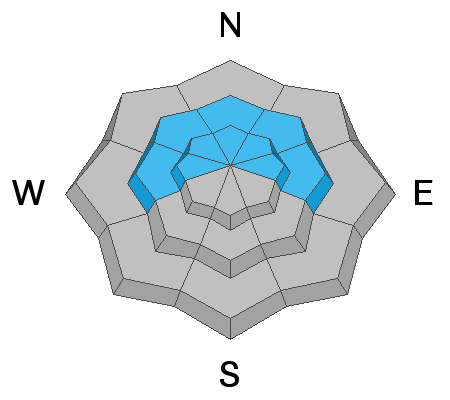Help us help you: Take this
quick quiz after you read the forecast. This will test what you've learned from today's forecast. You'll get feedback on what you learned and we'll find out how well we are conveying our message. You'll automatically be entered in a drawing for gear at the end of the season.
Temperatures range through the 20's F and skies are partly cloudy. Winds are from the west/southwest and at mid-elevations are averaging in the 20's with gusts in the 30's. Along the upper-most ridges, winds are averaging in the 30's and 40's with gusts in the 50's mph.
Storm totals from the past few days may have modest snow amounts, but impressive water (Snow Water Equivalent, or SWE) numbers:
Little Cottonwood 20"/3.75"
Big Cottonwood 16"/2.6"
Park City Ridgeline 15"/2.3"
Further to our north, the Logan mountains picked up over 2' of snow containing over 6" of water.
Snow quality is decent above about 9,500' with dense, surfy snow that makes for easy and fun travel and riding conditions. Once you drop below that elevation, the snow becomes increasingly damp to saturated.
Mostly clear skies this morning will give way to increasing clouds this afternoon. Winds will be from the west/southwest and it will be breezy. At mid elevations winds will average in the teens with gusts in the 20's mph. Along upper elevation ridges, winds will average in the 30's with gusts in the 50's mph. Temperatures will be quite warm for early January, with 10,000' temperatures rising into the mid 30's F. Snowfall overnight with minor accumulations into Saturday - hopefully we'll pick up 4" from this storm. Colder temperatures forecast for the weekend with high pressure building into the region.
Unfortunately, once the Friday night/Saturday storms clear out there no storms are forecast for at least the next several days.
Our
Week in Review - where we highlight significant snow and weather events -
has been published.
Backcountry observations from Thursday include three natural avalanches that likely ran sometime during the day on Wednesday or early Thursday morning.
These two avalanches likely failed within recent storm/wind-blown snow.
The most impressive was the
Silver Fork Headwall which was 2' deep (although deeper in places) and 800' wide. This slide also involved mostly new snow but may have also stepped down into old faceted snow in places.












